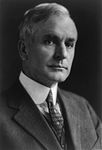Special election
| |||||||||||||||||
| |||||||||||||||||
 County results Brock: 50–60% 60–70% 70–80% 80–90% >90% Meacham: 50–60% | |||||||||||||||||
| |||||||||||||||||
Democratic primary
Candidates
- John Randolph Neal Jr., attorney, law professor, politician, and activist
- William E. Brock, incumbent senator
Special Democratic primary (August 7, 1930) [4] Party Candidate Votes % Democratic William E. Brock (incumbent) 113,492 70.67 Democratic John Randolph Neal Jr. 47,110 29.33 Majority 66,382 41.33 Turnout 6.14
General election
| Party | Candidate | Votes | % | |
|---|---|---|---|---|
| Democratic | William E. Brock (incumbent) | 144,019 | 74.40 | |
| Republican | F. Todd Meacham | 49,554 | 25.60 | |
| Majority | 94,465 | 48.80 | ||
| Turnout | 193,573 | |||
| Democratic hold | ||||




